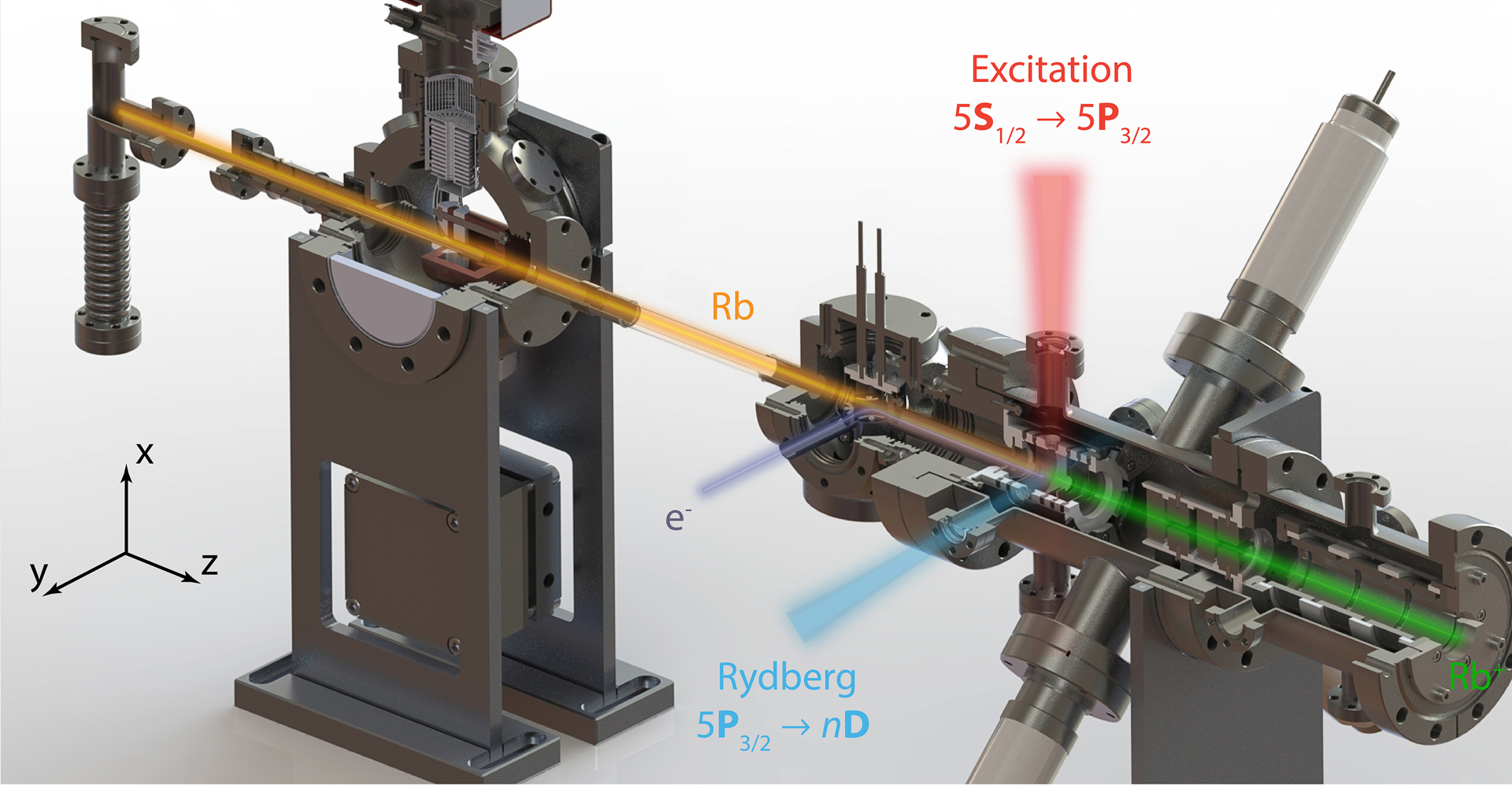Cold Atom Electron and Ion Source (CAEIS)

How do you take pictures of really small things? With a microscope of course. But is it so simple? With an optical microscope you can see a human cell – but not what’s inside it. Electron microscopes can see inside the cell, even down to single atoms, but they are incredibly slow, for example it can take a year to determine the structure of a protein molecule. X-rays from synchrotrons and x-ray free electron lasers (XFELs) can do that much more quickly, for molecules that form crystals, but many molecules are not so accommodating. And they are a tad on the expensive side, more than $1 billion for an XFEL. That’s an expensive microscope!
Back to electrons, and our new cold-atom electron source. Electron microscopes use tiny (really tiny) field-emission tips as electron sources, but as the electrons leave the tiny tip they repel each other which makes the images fuzzy. So they have to use low electron currents to get sharp images. But if you could make cold electrons – electrons that come from a fat source, but which are in a parallel beam (rather like a laser beam), then you can get sharp images with high electron current, and thus do much faster imaging.
We start with cold atoms, really cold atoms: the atoms are cooled with laser beams to less than 100 millionths of a degree above absolute zero. The atoms are then ionised, releasing electrons that are a thousand times colder than in conventional electron microscopes. We can create electron beams with complex shapes (see above) and because they are so cold, they retain their shape as they propagate to the target.
Why are cold electrons useful for imaging? We scatter the electrons from some target, and detect where they scatter to. Because the electrons are initially very cold, they travel in a very parallel beam, so we know the where they came from before they scattered. And we detect where they scatter to after they hit the target. The only unknown is the target, so from initial and final electron momenta we can calculate the target structure. There are lots of complications but that’s exactly what we enjoy, solving interesting problems.
These new cold electron (and cold ion) sources based on photo-ionisation of laser-cooled atoms have attracted enormous interest for their potential to take us another step towards the ultimate goal of creating molecular movies: ultrafast imaging of molecular structure, so we can see atoms bonding to form molecules, or proteins folding, or biological molecules interacting in the fundamental processes of life.
Pioneers in this area include our international colleagues at The Eindhoven University of Technology (Netherlands), The National Institute for Standards and Technology (USA), CNRS (France), Durham University (UK), and The University of Pisa (Italy). Some of our work includes:
- Demonstration of electron-bunch shaping with a CAEIS – Nature Physics (2011);
- Creating ultra-fast and cold electron bunches from a CAEIS – Nature Communications (2013);
- Detailed observation of charged-bunch self-interactions – Nature Communications (2014); and
- The first demonstration of single-shot diffraction imaging using a CAEIS – Journal of Physics B (2015).
We’re now working on a second-generation CAEIS, using an intense atomic beam to allow generation of high-current electron and ion beams (pictured below), and demonstrating electron diffraction imaging of “interesting” objects including nanofabricated devices and crystallised biomolecules.
For more information contact Andy McCulloch or Rob Scholten.

Related Publications
- Suppression of Emittance Growth Using a Shaped Cold Atom Electron and Ion Source
- D. J. Thompson, D. Murphy, R. W. Speirs, R. M. W. van Bijnen, A. J. McCulloch, R. E. Scholten, B. M. Sparkes Physical Review Letters 117, 193202 (2016) [pdf]
- Cold electron sources using laser-cooled atoms
- A. J. McCulloch, B. M. Sparkes, R. E. Scholten, Journal of Physics B 49, 164004 (2016) [pdf]
- Single-shot electron diffraction using a cold atom electron source
- R. W. Speirs, C. T. Putkunz, A. J. McCulloch, K. A. Nugent, B. M. Sparkes, R. E. Scholten, Journal of Physics B 48, 214002 (2015) [pdf]
- High-Coherence Electron and Ion Bunches from Laser-Cooled Atoms
- A. J. McCulloch, D. V. Sheludko, C.T. Putkunz, S. D. Saliba, J. D. Thompson, R. W. Speirs, D. Murphy, J. Torrance, B. M. Sparkes, R. E. Scholten, Journal of Physics: Conference Series 488, 012045 (2014) [pdf]
- Detailed observation of space–charge dynamics using ultracold ion bunches
- D. Murphy, R. W. Speirs, D. V. Sheludko, C. T. Putkunz, A. J. McCulloch, B. M. Sparkes, R. E. Scholten, Nature Communications 5, 4489 (2014) [pdf]
- High-Coherence Electron and Ion Bunches From Laser-Cooled Atoms
- B. M. Sparkes, D. J. Thompson, A. J. McCulloch, D. Murphy, R. W. Speirs, J. S. J. Torrance, R. E. Scholten, Microscopy and Microanalysis 20, 1008 (2014)
- Generation of shaped cold electron bunches for ultrafast diffraction imaging
- A. J. McCulloch, PhD Thesis (2013)
- High coherence picosecond electron bunches from cold atoms
- A. J. McCulloch, D. V. Sheludko M. Junker, R. E. Scholten, Nature Communications 4,1692 (2013) [pdf]
- Spatial coherence of electron bunches extracted from an arbitrarily shaped cold atom electron source
- S. D. Saliba, C. T. Putkunz, D. V. Sheludko, A. J. McCulloch, K. A. Nugent, R. E. Scholten, Optics Express 20, 3967 (2012) [pdf]
- A cold atom electron source for diffractive imaging
- S. D. Saliba, PhD Thesis (2011)
- Arbitrary shaped high-coherence electron bunches from ultracold plasma
- A. J. McCulloch, D. V. Sheludko, S. D. Saliba, S. C. Bell, M. Junker, K. A. Nugent, R. E. Scholten, Nature Physics 7, 785 (2011)
- Shaped electron bunches from ultracold plasma
- D. V. Sheludko, PhD Thesis (2010)